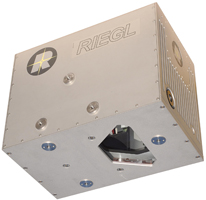New wavelengths for bathymetric, snow-and-ice applications
ORLANDO – Riegl kicked off its first ever International Airborne and Mobile User Conference here yesterday with a first day that featured the release of two new scanning systems featuring two new laser wavelengths for the company. The “1 micron” VQ-580 is designed for airborne applications likely to feature snow- and ice-covered terrain. The VQ-820-G is a visible green laser designed for bathymetric applications.
“The world looks different at different wavelengths,” said Vladimir Kadatskiy, engineering support manager with Riegl USA. While at the 1550 nanometer wavelength used by the VQ-480 you can only get 10 percent target reflectivity for snow and ice at 400 meters, with the 1064 namometer wavelength used by the 580, “you get 75 percent target reflectivity,” at up to 900 meters, Kadatskiy said.
One audience member asked why, considering firms like Optech and Leica use 1 micron wavelengths for their standard airborne scanners, Riegl considered the wavelength specialized for snow and ice. “One important point with our instrument is eye safety,” said Peter Rieger, product manager for airborne laser scanning. “At 1.5 micron, the eye safety is easy to achieve, but at 1 micron it’s less eye safe [the 580 is rated Class 3B, with a nominal ocular hazard distance of 105 meters]. Of course, at 1.5 micron, water surfaces, ice, and snow resolves poorly, so the demand for an instrument that is on one hand capable of measuring snow and ice, while keeping balance with eye safety, is there. So for the specific use on snow and ice, you can use the 1 micron, but you can also use it for everyday data acquisition, no question.”
Eye safety is yet more of an issue with the bathymetric system, VQ-820-G. The green laser emitted at the 532 nanometer wavelength is Class 3B, with an NOHD of 80 meters, and could cause damage to someone viewing through a telescope, say, at a distance of as much as 800 meters.
However, the tradeoff is that the laser can penetrate water down to 1 secchi depth at 250 khz, meaning essentially if a target is visible to the human eye from the surface, the laser can get there and measure. As for the market, Rieger said recent EU regulations regarding the monitoring and maintaining of inland bodies of water make for clear demand for the bathymetric system. “The all have to be assessed,” he said, “including for morphological status. A bathymetric scanner should be useful for this.”
An audience member asked yet another question that may have been top of mind for many: Why can’t one device be made that operates at these differently useful wavelengths?
“The internal calibration is really difficult,” Rieger said. “It is not so easy to create a stable instrument that uses multiple lasers in one system. However, these systems are small and lightweight, so they could be used simultaneously, side by side, without danger of interference. We’ve aimed at small instruments that are then combined on a common platform.”
And, of course, Rieger allowed with a chuckle, should a customer decide to acquire more than one of these sensors to address various applications, “that would be good for us.”






